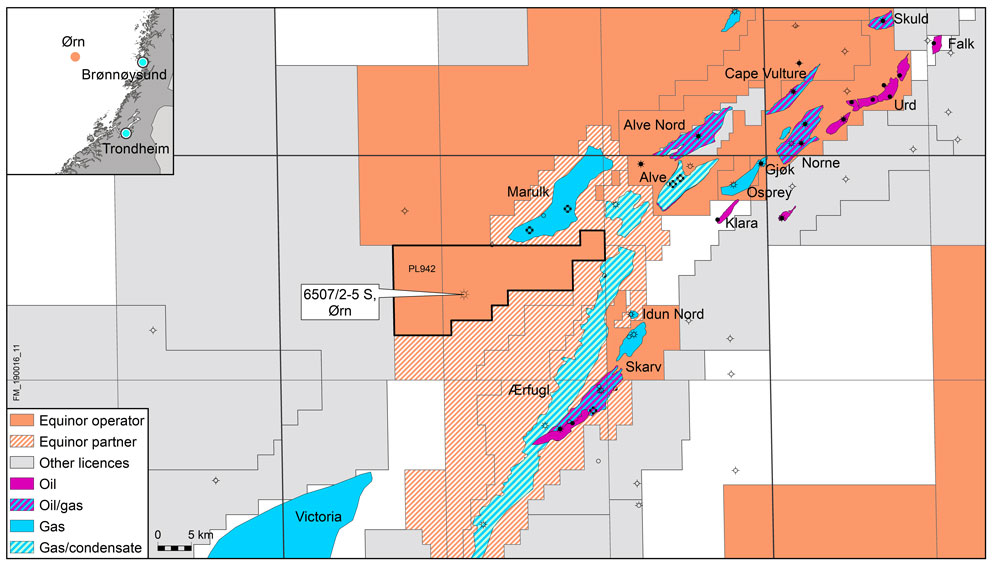Equinor Finds Gas in the Norwegian Sea and Starts Production From the Utgard Field
Equinor and its partners AkerBP and Wellesley Petroleum have found gas in the Ørn exploration well south-west of the Marulk field in the Norwegian Sea. Recoverable resources are estimated at 8–14 million standard cubic metres of oil equivalent, corresponding to 50–88 million barrels of oil equivalent (boe).
“This is good news. The Ørn discovery proves that there are still opportunities on the Norwegian continental shelf and reconfirms the Norwegian Sea’s importance to our domestic activity,” says Nick Ashton, Equinor’s senior vice president for exploration in Norway and the UK.
Exploration well 6507/2-5 S in production licence (PL) 942 was drilled around 12 kilometres south-west of the Marulk field, 38 kilometres south-west of the Norne field and 20 kilometres north-west of Skarv. The partnership will evaluate the discovery and clarify the need for delineation.
“The discovery follows several discoveries we have made in the same area during the past years, adding considerable volumes in an area with an already developed infrastructure. This gives us the opportunity to recover the resources profitably for both the licensees and society,” says Ashton.
In June, Equinor announced the Snadd Outer Outer/Black Vulture oil and gas discoveries south-west of the Norne field. Since 2017, Equinor has been operator of or partner in several discoveries in the Norwegian Sea totalling an estimated volume of 200-650 million boe.
6507/2-5 S is the first exploration well in PL942, which was included in the 2017 awards in predefined areas (APA). The licensees are Equinor (operator, 40%), AkerBP (30%) and Wellesley (30%).
Drilled by the West Phoenix drilling rig to a vertical depth of 4147 metres below sea level, the well was concluded in the Tilje formation in Early Jurassic rocks. Water depth in the area is 332 metres.
The well has been permanently plugged and abandoned.
Utgard Field on Stream
On 16 September, Equinor and its partners started production from the Utgard gas and condensate field, spanning the Norwegian-UK border in the North Sea. The project is delivered without any personal injuries, ahead of schedule and 25% below the cost estimate.
Recoverable Utgard resources are estimated at around 40 million barrels of oil equivalent (boe) and daily production on plateau will be around 43,000 boe.
The field development consists of two wells from a subsea template tied back to the Sleipner field by a pipeline and an umbilical. The template is installed on the Norwegian side of the border, with one well on each side.
The field was discovered in 1982 and a development has been considered several times. In 2016, Equinor acquired the UK share of the discovery to realize the development, which has become a profitable project even with substantially lower oil prices than we see today.
The plan for development and operation and the field development plan were submitted to Norwegian and UK authorities in 2016. At that time the cost estimate was NOK 3.5 billion (fixed NOK), and start-up was scheduled for the end of 2019.
“I am proud of the Utgard project being delivered at NOK 900 million below the cost estimate and ahead of schedule, but first and foremost of the project being delivered without personal injuries,” says Anders Opedal, executive vice president for Technology, Projects and Drilling in Equinor.
It is the first time Equinor leads a field development for recovering resources across the border between the Norwegian and UK continental shelves.
“Good and efficient cross-border cooperation with both licence partners and authorities has made the Utgard development possible, and I am pleased that we found solutions ensuring proper resource management on both sides,” says Opedal.
“Through Utgard, we are maximizing economic recovery from the North Sea, and unlocking high value, low carbon intensity barrels in line with our strategy. We will continue to seek cross-border opportunities to add value on both sides of the border,” says Arne Gürtner, senior vice president for UK and Ireland Offshore in Equinor.
Utgard will be remote-operated from the Norwegian Sleipner field, where the well stream will be processed before dry gas is transported to the market through the Gassled pipeline system, and liquids are sent through the existing pipeline to Kårstø for further export to Europe. Utgard will also utilize Sleipner’s facility for CO2 purification and storage.
“By reusing the existing infrastructure, we can, with relatively low investments, realize smaller discoveries that would not otherwise have been profitable enough to develop. At the same time, we are adding valuable volumes to Sleipner,” says Arne Sigve Nylund, executive vice president for Development and Production Norway in Equinor.
The Sleipner area embraces the gas and condensate fields Sleipner Øst, Gungne and Sleipner Vest. The Sleipner installations are also processing hydrocarbons from the tie-in fields Sigyn, Volve, Gudrun and from 2017 also rich gas from Gina Krog.
Sleipner consists of the following installations: Sleipner A – Processing, drilling and Living quarter platform; Sleipner R – Riser platform for gas export and condensate export; Sleipner T – Processing and CO2 removal platform; Sleipner B – Unmanned production platform.







